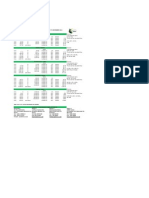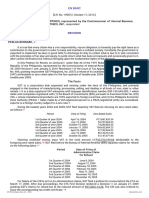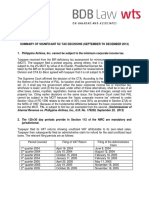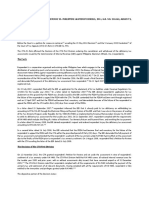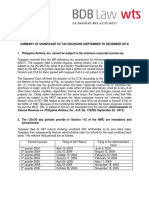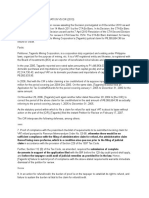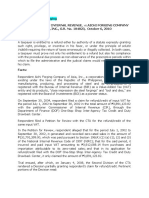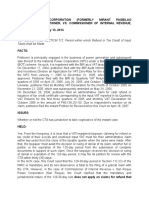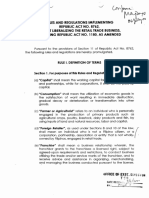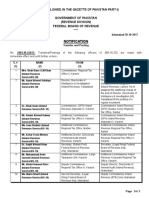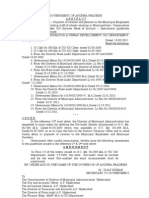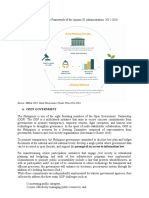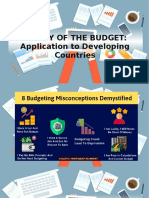Labor Case
Labor Case
Uploaded by
Angelica VasquezCopyright:
Available Formats
Labor Case
Labor Case
Uploaded by
Angelica VasquezOriginal Description:
Original Title
Copyright
Available Formats
Share this document
Did you find this document useful?
Is this content inappropriate?
Copyright:
Available Formats
Labor Case
Labor Case
Uploaded by
Angelica VasquezCopyright:
Available Formats
pdfcrowd.com open in browser PRO version Are you a developer?
Try out the HTML to PDF API
Today is Sunday, July 13, 2014
Republic of the Philippines
SUPREME COURT
Manila
EN BANC
G.R. No. 190872 October 17, 2013
REPUBLIC OF THE PHILIPPINES represented by the Commissioner of InternaI Revenue, Petitioner,
vs.
GST PHILIPPINES, INC., Respondent.
D E C S O N
PERLAS-BERNABE,
t is true that every citizen has a civic responsibility nay an obligation to honestly pay the right taxes as a
contribution to the government in order to keep and maintain a civilized society. Corollarily, the government is
expected to implement tax laws in good faith; to discharge its duty to collect what is due to it; and consistent with
the principles of fair play and equity to justly return what has been erroneously and excessively given to it after
careful verification but without infringing upon the fundamental rights of the taxpayer.
n this Petition for Review on Certiorari
1
under Rule 45 of the 1997 Rules of Civil Procedure, petitioner Republic of
the Philippines, represented by the Commissioner of nternal Revenue (CR), assails the October 30, 2009
Decision
2
and January 5, 2010 Resolution
3
of the Court of Tax Appeals (CTA) En Banc in C.T.A. EB No. 484,
granting respondent GST Philippines, nc. (GST) a refund of its unutilized excess input value added tax (VAT)
attributable to zero-rated sales for the four quarters of taxable year 2004 and the first three quarters of taxable
year 2005.
pdfcrowd.com open in browser PRO version Are you a developer? Try out the HTML to PDF API
The facts
GST is a corporation duly organized and existing under the laws of the Philippines, and primarily engaged in the
business of manufacturing, processing, selling, and dealing in all kinds of iron, steel or other metals.
4
t is a duly
registered VAT enterprise with taxpayer identification number 000-155-645-000,
5
which deals with companies
registered with (1) the Board of nvestments (BO) pursuant to Executive Order No. (EO) 226,
6
whose
manufactured products are 100% exported to foreign countries; and (2) the Philippine Economic Zone Authority
(PEZA).
7
Sales made by a VAT-registered person to a PEZA-registered entity are considered exports to a foreign
country subject to a zero rate.
8
During the taxable years 2004 and 2005, GST filed Quarterly VAT Returns showing its zero-rated sales, as
follows:
9
Period Date of Filing Zero-Rated Sales
1st Quarter of year 2004 April 16, 2004 P 77,687,420.54
2nd Quarter of year 2004 July 15, 2004 53,737,063.05
3rd Quarter of year 2004 October 15, 2004 74,280,682.00
4th Quarter of year 2004 January 11, 2005 104,633,604.23
1st Quarter of year 2005 April 25, 2005 37,742,969.02
2nd Quarter of year 2005 July 19, 2005 56,133,761.00
3rd Quarter of year 2005 October 26, 2005 51,147,677.80
Claiming unutilized excess input VAT in the total amount of P32,722,109.68 attributable to the foregoing zero-rated
sales,
10
GST filed before the Bureau of nternal Revenue (BR) separate claims for refund on the following
dates:
11
Period Date of FiIing of
pdfcrowd.com open in browser PRO version Are you a developer? Try out the HTML to PDF API
Administrative CIaim
For Refund
1st Quarter of year 2004 June 9, 2004
2nd Quarter of year 2004 August 12, 2004
3rd Quarter of year 2004 February 18, 2005
4th Quarter of year 2004 February 18, 2005
1st Quarter of year 2005 May 11, 2005
2nd Quarter of year 2005 November 18, 2005
3rd Quarter of year 2005 November 18, 2005
For failure of the CR to act on its administrative claims, GST filed a petition for review before the CTA on March
17, 2006. After due proceedings, the CTA First Division rendered a Decision
12
on January 27, 2009 granting
GST's claims for refund but at the reduced amount of P27,369,114.36. The CR was also ordered to issue the
corresponding tax credit certificate.
13
The CR moved for reconsideration, which was denied
14
by the CTA First Division for lack of merit, thus, prompting
the elevation of the case to the CTA En Banc via a petition for review.
15
The CR raised therein the failure of GST to substantiate its entitlement to a refund,
16
and argued that the judicial
appeal to the CTA was filed beyond the reglementary periods prescribed in Section 112 of RA 8424
17
(Tax
Code).
18
On October 30, 2009, the CTA En Banc affirmed
19
the Decision of the CTA First Division finding GST's
administrative and judicial claims for refund to have been filed well within the prescribed periods provided in the
Tax Code.
20
The CR's motion for reconsideration was denied by the CTA En Banc in its Resolution
21
dated
January 5, 2010.
Hence, the instant petition.
pdfcrowd.com open in browser PRO version Are you a developer? Try out the HTML to PDF API
The ssue
The CR no longer raises the alleged failure of GST to comply with the substantiation requirements for the
questioned claims for refund nor questions the reduced award granted by the CTA En Banc in the amount of
P27,369,114.36. Thus, the lone issue for resolution is whether GST's action for refund has complied with the
prescriptive periods under the Tax Code.
The Ruling of the Court
Laws Providing Refunds or Tax
Credit of Unutilized Excess nput VAT
Refund or tax credit of unutilized excess input VAT has been allowed as early as in the Original VAT Law EO
273.
22
This was later amended by RA 7716
23
and RA 8424, and further amended by RA 9337
24
which took effect
on November 1, 2005.
25
Since GST's claims for refund covered the periods before the effectivity of RA 9337, the
old provision on VAT refund, specifically Section 112, as amended by RA 8424, shall apply.
26
t reads:
Section 112. Refunds or Tax Credits of nput Tax.
(A) Zero-rated or Effectively Zero-rated Sales. Any VAT-registered person, whose sales are zero-rated or
effectively zero-rated may, within two (2) years after the close of the taxable quarter when the sales were made,
apply for the issuance of a tax credit certificate or refund of creditable input tax due or paid attributable to such
sales, except transitional input tax, to the extent that such input tax has not been applied against output tax: x x x.
(Emphasis supplied)
x x x x
(D) Period within which Refund or Tax Credit of nput Taxes shall be Made. n proper cases, the Commissioner
shall grant a refund or issue the tax credit certificate for creditable input taxes within one hundred twenty (120)
days from the date of submission of complete documents in support of the application filed in accordance with
Subsections (A) and (B) hereof.
n case of full or partial denial of the claim for tax refund or tax credit, or the failure on the part of the
Commissioner to act on the application within the period prescribed above, the taxpayer affected may, within thirty
(30) days from the receipt of the decision denying the claim or after the expiration of the one hundred twenty day-
period, appeal the decision or the unacted claim with the Court of Tax Appeals. (Emphasis supplied)
pdfcrowd.com open in browser PRO version Are you a developer? Try out the HTML to PDF API
The CR, adopting the dissenting opinion
27
of CTA Presiding Justice Ernesto D. Acosta to the CTA En Banc
Decision dated October 30, 2009, maintains that the two-year prescriptive period under Section 112 (A) of the Tax
Code reckoned from the close of the taxable quarter involved is limited only to the filing of an administrative not
judicial claim.
28
n turn, under paragraph (D) of the same Section, the CR has 120 days to decide on the claim
counted from the date of the submission of complete documents and not from the mere filing of the administrative
claim. The taxpayer then has 30 days from receipt of the adverse decision, or from the expiration of the 120-day
period without the CR acting upon the claim, to institute his judicial claim before the CTA.
29
Thus, in the present case, the claims filed for the four quarters of taxable year 2004, as well as the first quarter of
taxable year 2005, had already prescribed. While those of the second and third quarters of taxable year 2005
were prematurely filed, as summarized in the table presented by Justice Acosta, to wit:
Applying the above discourse in the case at bar, a table is prepared for easy reference:
FiIing of
Administrative
CIaim
120th day
Section 112
(D), NIRC of
1997
30th day Section
112 (D), 2nd par.,
NIRC of 1997
FiIing of the Petition
before the First
Division of this Court
Remarks
June 9, 2004
October 7,
2004
November 6, 2004 March 17, 2006 Prescribed
August 12,
2004
December 10,
2004
January 9, 2005 March 17, 2006 Prescribed
February 18,
2005
June 18, 2005 July 18, 2005 March 17, 2006 Prescribed
May 11, 2005 September 8,
2005
October 8, 2005 March 17, 2006 Prescribed
November 18,
2005
March 18,
2006
April 17, 2006 March 17, 2006 Prescribed
Based on the above, the filing of the Petition for Review before the First Division has already prescribed with
pdfcrowd.com open in browser PRO version Are you a developer? Try out the HTML to PDF API
respect to the administrative claim filed on June 9, 2004; August 12, 2004; February 18, 2005; and May 11, 2005
for being filed beyond the 30th day provided under the second paragraph of Section 112 (D) of the NRC of 1997.
The petition is therefore dismissible for being out of time.
Anent the administrative claim filed on November 18, 2005, the filing of the petition before the First Division is
premature for failure of respondent to wait for the 120-day period to expire. t failed to exhaust the available
administrative remedies. Hence, the instant petition is likewise dismissible for lack of cause of action.
30
For its part, GST asserts that under Section 112 (A) of the Tax Code, the prescriptive period is complied with if
both the administrative and judicial claims are filed within the two-year prescriptive period;
31
and that compliance
with the 120-day and 30-day periods under Section 112 (D) of the Tax Code is not mandatory.
32
t explained that
the 30-day period only refers to a case where a decision is rendered by the CR and not when the claim for refund
is not acted upon, in which case, the taxpayer may appeal to the CTA anytime even prior to or after the expiration
of the 120-day period as long as it is within the two-year prescriptive period. On the other hand, the CR may still
choose to resolve the administrative claim even beyond the 120-day period. n any case, compliance with the 120-
day and 30-day periods is merely directory and permissive, not mandatory nor jurisdictional.
33
The 120+30 day periods are
mandatory and jurisdictional.
The Court had already clarified in the case of CR v. Aichi Forging Company of Asia, nc. (Aichi),
34
promulgated on
October 6, 2010, that the two-year prescriptive period applies only to administrative claims and not to judicial
claims. Morever, it was ruled that the 120-day and 30-day periods are not merely directory but mandatory.
Accordingly, the judicial claim of Aichi, which was simultaneously filed with its administrative claim, was found to be
premature. The Court held:
n fact, applying the two-year period to judicial claims would render nugatory Section 112(D) [now Section 112 (C)]
of the NRC, which already provides for a specific period within which a taxpayer should appeal the decision or
inaction of the CR.
The second paragraph of Section 112(D) [now Section 112 (C)] of the NRC envisions two scenarios: (1) when a
decision is issued by the CR before the lapse of the 120-day period; and (2) when no decision is made after the
120-day period. n both instances, the taxpayer has 30 days within which to file an appeal with the CTA. As we see
it then, the 120-day period is crucial in filing an appeal with the CTA.
35
(Emphasis supplied)
pdfcrowd.com open in browser PRO version Are you a developer? Try out the HTML to PDF API
The taxpayer will always have 30 days to file the judicial claim even if the Commissioner acts only on the 120th
day, or does not act at all during the 120-day period. With the 30-day period always available to the taxpayer, the
taxpayer can no longer file a judicial claim for refund or tax credit of unutilized excess input VAT without waiting for
the Commissioner to decide until the expiration of the 120-day period.
36
Failure to comply with the 120-day waiting
period violates the doctrine of exhaustion of administrative remedies and renders the petition premature and thus
without a cause of action, with the effect that the CTA does not acquire jurisdiction over the taxpayer's petition.
37
San Roque case provides exception to the strict compliance with the 120-day period
While the Court En Banc reiterated in the recent consolidated cases of CR v. San Roque Power Corporation (
San Roque ),
38
promulgated on February 12, 2013, that the 120-day period is mandatory and jurisdictional,
however, it categorically held that BR Ruling No. DA-489-03 dated December 10, 2003 provided a valid claim for
equitable estoppel under Section 246
39
of the Tax Code. BR Ruling No. DA-489-03 expressly states that the
"taxpayer-claimant need not wait for the lapse of the 120-day period before it could seek judicial relief with the
CTA by way of Petition for Review."
40
Speaking through Associate Justice Antonio T. Carpio, the Court
ratiocinated as follows:
There is no dispute that the 120-day period is mandatory and jurisdictional, and that the CTA does not acquire
jurisdiction over a judicial claim that is filed before the expiration of the 120-day period. There are, however, two
exceptions to this rule. The first exception is if the Commissioner, through a specific ruling, misleads a particular
taxpayer to prematurely file a judicial claim with the CTA. Such specific ruling is applicable only to such particular
taxpayer. The second exception is where the Commissioner, through a general interpretative rule issued under
Section 4 of the Tax Code, misleads all taxpayers into filing prematurely judicial claims with the CTA. n these
cases, the Commissioner cannot be allowed to later on question the CTA's assumption of jurisdiction over such
claim since equitable estoppel has set in as expressly authorized under Section 246 of the Tax Code.
Section 4 of the Tax Code, a new provision introduced by RA 8424, expressly grants to the Commissioner the
power to interpret tax laws, thus:
Sec. 4. Power of the Commissioner To nterpret Tax Laws and To Decide Tax Cases. The power to interpret the
provisions of this Code and other tax laws shall be under the exclusive and original jurisdiction of the
Commissioner, subject to review by the Secretary of Finance.
The power to decide disputed assessments, refunds of internal revenue taxes, fees or other charges, penalties
imposed in relation thereto, or other matters arising under this Code or other laws or portions thereof administered
pdfcrowd.com open in browser PRO version Are you a developer? Try out the HTML to PDF API
by the Bureau of nternal Revenue is vested in the Commissioner, subject to the exclusive appellate jurisdiction of
the Court of Tax Appeals.
Since the Commissioner has exclusive and original jurisdiction to interpret tax laws, taxpayers acting in good faith
should not be made to suffer for adhering to general interpretative rules of the Commissioner interpreting tax laws,
should such interpretation later turn out to be erroneous and be reversed by the Commissioner or this Court.
ndeed, Section 246 of the Tax Code expressly provides that a reversal of a BR regulation or ruling cannot
adversely prejudice a taxpayer who in good faith relied on the BR regulation or ruling prior to its reversal. x x x.
41
BR Ruling No. DA-489-03 was classified in San Roque as a general interpretative rule having been made in
response to a query by a government agency tasked with processing tax refunds and credits the One Stop Shop
nter-Agency Tax Credit and Drawback Center of the Department of Finance. As such, all taxpayers can rely on
said ruling from the time of its issuance on December 10, 2003 up to its reversal by this Court in Aichi on October
6, 2010, where it was held that the 120+30 day periods are mandatory and jurisdictional.
42
Therefore, GST can benefit from BR Ruling No. DA-489-03 with respect to its claims for refund of unutilized
excess input VAT for the second and third quarters of taxable year 2005 which were filed before the CR on
November 18, 2005 but elevated to the CTA on March 17, 2006 before the expiration of the 120-day period
(March 18, 2006 being the 120th day). BR Ruling No. DA-489-03 effectively shielded the filing of GST's judicial
claim from the vice of prematurity.
43
GST's claims, however, for the four quarters of taxable year 2004 and the first quarter of taxable year 2005 should
be denied for late filing of the petition for review before the CTA. GST filed its VAT Return for the first quarter of
2004 on April 16, 2004. Reckoned from the close of the first taxable quarter of 2004 on March 31, 2004, the
administrative claim filed on June 9, 2004 was well within the required two-year prescriptive period from the close
of the taxable quarter, the last day of filing being March 31, 2006. The CR then had 120 days from June 9, 2004,
or until October 7, 2004, to decide the claim. Since the Commissioner did not act on the claim within the said
period, GST had 30 days from October 7, 2004, or until November 6, 2004, to file its judicial claim. However, GST
filed its petition for review before the CTA only on March 17, 2006, or 496 days after the last day of filing. n short,
GST was late by one year and 131 days in filing its judicial claim.
For the second quarter of taxable year 2004, GST filed its administrative claim on August 12, 2004. The 120-day
period from the filing of such claim ended on December 10, 2004, and the 30th day within which to file a judicial
claim fell on January 9, 2005. However, GST filed its petition for review before the CTA only on March 17, 2006, or
432 days after the last day of filing.
pdfcrowd.com open in browser PRO version Are you a developer? Try out the HTML to PDF API
GST was late by one year and 67 days in filing its judicial claim.
For the third and fourth quarters of taxable year 2004, GST filed its administrative claims on February 18, 2005.
The 120th day, or June 18, 2005, lapsed without any action from the CR. Thus, GST had 30 days therefrom, or
until July 18, 2005, to file its judicial claim, but it did so only on March 17, 2006, or 242 days after the last day of
filing. GST was late by 242 days in filing its judicial claim.
Finally, for the first quarter of taxable year 2005, GST filed its administrative claim on May 11, 2005. The 120-
day period ended on September 8, 2005, again with no action from the CR. Nonetheless, GST failed to elevate its
claim to the CTA within 30 days, or until October 8, 2005. The petition for review filed by GST on March 17, 2006,
or 160 days after the last day of filing was, therefore, late.
Following is a tabular summation of the relevant dates of GST's administrative and judicial claims, and the
corresponding action on said claims:
Taxable
Period
Filing of
Administrative
claim
120th day
[Section
112(D), NRC
of 1997]
30th day
[Section
112(D), NRC
of 1997]
Filing of
Judicia
lClaim
Remarks
Action
on Claim
1st
Quarter
2004
June 9, 2004
October 7,
2004
November 6,
2004
March
17,
2006
Field late DENY
pursuant
to
Section
112 (C),
NRC of
1997
2nd
Quarter
2004
August 12,
2004
December 10,
2004
January 9,
2005
March
17,
2006
Field late DENY
pursuant
to
Section
112 (C),
NRC of
1997
pdfcrowd.com open in browser PRO version Are you a developer? Try out the HTML to PDF API
3rd
Quarter
2004
February 18,
2005
June 18,
2005
July 18, 2005 March
17,
2006
Field late DENY
pursuant
to
Section
112 (C),
NRC of
1997
4th
Quarter
2004
February 18,
2005
June 18,
2005
July 18, 2005 March
17,
2006
Field late DENY
pursuant
to
Section
112 (C),
NRC of
1997
1st
Quarter
2005
May 11, 2005 September 8,
2005
October 8,
2005
March
17,
2006
Field late
DENY
pursuant
to
Section
112 (C),
NRC of
1997
2nd
Quarter
2005
November 18,
2005
March 18,
2006
April 17, 2006 March
17,
2006
Prematurely
filed
GRANT
pursuant
to BR
Ruling
No. DA-
489-03
3rd
Quarter
2005
November 18,
2005
March 18,
2006
April 17, 2006 March
17,
2006
Prematurely
filed
GRANT
pursuant
to BR
Ruling
No. DA-
pdfcrowd.com open in browser PRO version Are you a developer? Try out the HTML to PDF API
489-03
As may be observed from the Court's application of the 120+30 day periods to GST's claims, the 120-day period is
uniformly reckoned from the date of the filing of the administrative claims. The CR insists,
44
however, that the
filing of the administrative claim was not necessarily the same time when the complete supporting documents were
submitted to the Commissioner.
The Court agrees. However, this issue is not determinative of the resolution of this case for failure of the CR to
show that GST further submitted supporting documents subsequent to the filing of its administrative claims. Thus,
the reckoning date of the 120-day period commenced simultaneously
45
with the filing of the administrative claims
when GST was presumed to have attached the relevant documents to support its applications for refund or tax
credit.
As a final note, it is incumbent on the Court to emphasize that tax refunds partake of the nature of tax exemptions
which are a derogation of the power of taxation of the State. Consequently, they are construed strictly against a
taxpayer and liberally in favor of the State.
46
Thus, as emphasized in Aichi, a taxpayer must prove not only its
entitlement to a refund but also its compliance with prescribed procedures.
47
WHEREFORE, the petition is PARTLY GRANTED. The Decision dated October 30, 2009 of the Court of Tax
Appeals En Banc in C.T.A. EB No. 484, affirming the Decision dated January 27, 2009 of the CTA First Division in
C.T.A. Case No. 7419, is AFFRMED with MODFCATON. The claims of respondent GST Philippines, nc. for
refund or tax credit for unutilized excess input VAT for the four quarters of taxable year 2004, as well as the first
quarter of taxable year 2005 are hereby DENED for being filed beyond the prescriptive period, while the claims for
refund for the second and third quarters of taxable year 2005 are GRANTED. Accordingly, the Commissioner of
nternal Revenue is ordered to refund or, in the alternative, to issue a tax credit certificate to respondent GST
Philippines, nc. corresponding only to the amount representing unutilized excess input VAT for the second and
third quarters of taxable year 2005 out of the total amount of P27,369,114.36 awarded by the CTA.
SO ORDERED.
ESTELA M. PERLAS-BERNABE
Associate Justice
WE CONCUR:
pdfcrowd.com open in browser PRO version Are you a developer? Try out the HTML to PDF API
MARIA LOURDES P. A. SERENO
Chief Justice
ANTONIO T. CARPIO
Associate Justice
PRESBITERO J. VELASCO, JR.
Associate Justice
TERESITA J. LEONARDO-DE CASTRO
Associate Justice
ARTURO D. BRION
Associate Justice
DIOSDADO M. PERALTA
Associate Justice
LUCAS P. BERSAMIN
Associate Justice
On Official Leave
MARIANO C. DEL CASTILLO
Associate Justice
On Official Leave
ROBERTO A. ABAD
Associate Justice
MARTIN S. VILLARAMA, JR.
Associate Justice
JOSE PORTUGAL PEREZ
Associate Justice
JOSE CATRAL MENDOZA
Associate Justice
BIENVENIDO L. REYES
Associate Justice
On Official Leave
MARVIC MARIO VICTOR F. LEONEN
Associate Justice
C E R T F C A T O N
certify that the conclusions in the above Decision had been reached in consultation before the case was
assigned to the writer o the opinion o the Court.
MARIA LOURDES P. A. SERENO
pdfcrowd.com open in browser PRO version Are you a developer? Try out the HTML to PDF API
Chief Justice
Footnotes
1
Rollo, pp. 8-27.
2
d. at 28-45. Penned by Associate Justice Juanito C. Castaeda, Jr., with Presiding Justice Ernesto D.
Acosta, dissenting, Associate Justices Erlinda P. Uy and Olga Palanca-Enriquez, concurring, and Associate
Justices Lovell R. Bautista and Caesar A. Casanova, both concurring and dissenting.
3
d. at 62-65. Penned by Associate Justice Juanito C. Castaeda, Jr., with Presiding Justice Ernesto D.
Acosta, dissenting, and Associate Justices Lovell R. Bautista, Erlinda P. Uy, Caesar A. Casanova, and Olga
Palanca-Enriquez, concurring.
4
d. at 9.
5
d. at 29.
6
Otherwise known as the "Omnibus nvestments Code of 1987."
7
Rollo, pp. 77-78.
8
See CR v. Seagate Technology (Phils.), 491 Phil. 317, 338-339 (2005), citing Section 106 (A)(2)(a)(5) of
RA 8424 in relation to EO 226 and RA 7916 (The Special Economic Zone Act of 1995).
9
Rollo, p. 30.
10
d.
11
d. at 44.
12
The said decision is not attached to the records of this case.
pdfcrowd.com open in browser PRO version Are you a developer? Try out the HTML to PDF API
13
Rollo, p. 30.
14
The CTA First Division's Resolution dated March 30, 2009 which denied CR's motion for reconsideration
was not attached in the records of this case.
15
Rollo, p. 30.
16
d. at 31.
17
"An Act Amending the National nternal Revenue Code, As Amended, and for Other Purposes." This is
otherwise known as the "Tax Reform Act of 1997" or the "National nternal Revenue Code of 1997."
18
Rollo, p. 41.
19
d. at 28-45.
20
d. at 44.
21
d. at 62-65.
22
"Adopting a Value-Added Tax, Amending for this Purpose Certain Provisions of the National nternal
Revenue Code, and for Other Purposes." t added Section 106 in the Tax Code and the pertinent provisions
read:
Sec. 106. Refunds or tax credits of input tax. x x x.
(b) Zero-rated or effectively zero-rated sales. Any person, except those covered by paragraph (a)
above, whose sales are zero-rated or are effectively zero-rated may, within two years after the close
of the quarter when such sales were made, apply for the issuance of a tax credit certificate or refund
of the input taxes attributable to such sales to the extent that such input tax has not been applied
against output tax.
x x x x
(e) Period within which refund of input taxes may be made by the Commissioner. The Commissioner
pdfcrowd.com open in browser PRO version Are you a developer? Try out the HTML to PDF API
shall refund input taxes within 60 days from the date the application for refund was filed with him or his
duly authorized representative. No refund of input taxes shall be allowed unless the VAT-registered
person files an application for refund within the period prescribed in paragraphs (a), (b) and (c), as
the case may be. x x x x
23
"An Act Restructuring the Value-Added Tax (VAT) System, Widening its Tax Base and Enhancing its
Administration, and for These Purposes Amending and Repealing the Relevant Provisions of the National
nternal Revenue Code, as Amended, and for Other Purposes." t further amended Section 106 and the
pertinent provisions read:
Sec. 106. Refunds or tax credits of creditable input tax.
(a) Any VAT-registered person, whose sales are zero-rated or effectively zero-rated, may, within two
(2) years after the close of the taxable quarter when the sales were made, apply for the issuance of a
tax credit certificate or refund of creditable input tax due or paid attributable to such sales, except
transitional input tax, to the extent that such input tax has not been applied against output tax:
Provided, however, That in the case of zero-rated sales under Section 100(a)(2)(A)(i), (ii) and (b) and
Section 102(b)(1) and (2), the acceptable foreign currency exchange proceeds thereof had been duly
accounted for in accordance with the regulations of the Bangko Sentral ng Pilipinas (BSP): Provided,
further, That where the taxpayer is engaged in zero-rated or effectively zero-rated sale and also in
taxable or exempt sale of goods or properties or services, and the amount of creditable input tax due
or paid cannot be directly and entirely attributed to any one of the transactions, it shall be allocated
proportionately on the basis of the volume of sales.
x x x x
(d) Period within which refund or tax credit of input taxes shall be made. n proper cases, the
Commissioner shall grant a refund or issue the tax credit for creditable input taxes within sixty (60)
days from the date of submission of complete documents in support of the application filed in
accordance with sub-paragraphs (a) and (b) hereof. n case of full or partial denial of the claim for tax
refund or tax credit, or the failure on the part of the Commissioner to act on the application within the
period prescribed above, the taxpayer affected may, within thirty (30) days from the receipt of the
decision denying the claim or after the expiration of the sixty-day period, appeal the decision or the
unacted claim with the Court of Tax Appeals.
x x x x
pdfcrowd.com open in browser PRO version Are you a developer? Try out the HTML to PDF API
24
"An Act Amending Sections 27, 28, 34, 106, 107, 108, 109, 110, 111, 112, 113, 114, 116, 117, 119, 121,
148, 151, 236, 237 and 288 of the National nternal Revenue Code of 1997, as Amended, and for Other
Purposes." Pertinent provisions of Section 112 now reads: Sec. 112.
Refunds or Tax Credits of nput Tax.
(A) Zero-Rated or Effectively Zero-Rated Sales. Any VAT-registered person, whose sales are zero-
rated or effectively zero-rated may, within two (2) years after the close of the taxable quarter when the
sales were made, apply for the issuance of a tax credit certificate or refund of creditable input tax due
or paid attributable to such sales, except transitional input tax, to the extent that such input tax has
not been applied against output tax: Provided, however, That in the case of zero-rated sales under
Section 106(A)(2)(a)(1), (2) and (b) and Section 108(B)(1) and (2), the acceptable foreign currency
exchange proceeds thereof had been duly accounted for in accordance with the rules and regulations
of the Bangko Sentral ng Pilipinas (BSP): Provided, further, That where the taxpayer is engaged in
zero-rated or effectively zero-rated sale and also in taxable or exempt sale of goods or properties or
services, and the amount of creditable input tax due or paid cannot be directly and entirely attributed
to any one of the transactions, it shall be allocated proportionately on the basis of the volume of
sales: Provided, finally, That for a person making sales that are zero-rated under Section 108(B)(6),
the input taxes shall be allocated ratably between his zero-rated and non-zero-rated sales.
x x x x
(C) Period within which Refund or Tax Credit of nput Taxes shall be Made. n proper cases, the
Commissioner shall grant a refund or issue the tax credit certificate for creditable input taxes within
one hundred twenty (120) days from the date of submission of complete documents in support of the
application filed in accordance with Subsection (A) hereof.
n case of full or partial denial of the claim for tax refund or tax credit, or the failure on the part of the
Commissioner to act on the application within the period prescribed above, the taxpayer affected may,
within thirty (30) days from the receipt of the decision denying the claim or after the expiration of the
one hundred twenty day-period, appeal the decision or the unacted claim with the Court of Tax
Appeals.
x x x x
pdfcrowd.com open in browser PRO version Are you a developer? Try out the HTML to PDF API
25
ts effectivity clause provides that it shall take effect on July 1, 2005 but its effectivity was suspended due
to a temporary restraining order (TRO) issued by the Court. The law finally took effect only on November 1,
2005 when the validity of the law was upheld and the TRO was lifted (see Abakada Guro Party List v.
Ermita, G.R. Nos. 168056, 168207, 168461, 168463 & 168730, September 1, 2005, 469 SCRA 1). See also
CR v. Philippine Global Communications, nc., G.R. No. 144696, August 16, 2006, 499 SCRA 53 regarding
the effect of a TRO on the effectivity of a law. t states that with the issuance of the TRO, the enforcement
and/or implementation of an entire law, not only the contested provisions, is stopped.
26
RA 9337 removed the grant to a taxpayer to refund input VAT arising from purchase of capital goods.
Other than that, RA 9337 did not significantly modify Section 112.
27
Rollo, pp. 46-54.
28
d. at 50.
29
d. at 52.
30
d. at 53-54.
31
d. at 82.
32
d. at 84.
33
d. at 82-84.
34
G.R. No. 184823, October 6, 2010, 632 SCRA 422.
35
d. at 444.
36
CR v. San Roque Power Corporation, G.R. Nos. 187485, 196113, and 197156, February 12, 2013, 690
SCRA 336, 398.
37
d. at 381.
pdfcrowd.com open in browser PRO version Are you a developer? Try out the HTML to PDF API
38
d.
39
Sec. 246. Non-Retroactivity of Rulings. Any revocation, modification or reversal of any of the rules and
regulations promulgated in accordance with the preceding Sections or any of the rulings or circulars
promulgated by the Commissioner shall not be given retroactive application if the revocation, modification or
reversal will be prejudicial to the taxpayers, except in the following cases: (a) Where the taxpayer
deliberately misstates or omits material facts from his return or any document required of him by the Bureau
of nternal Revenue; (b) Where the facts subsequently gathered by the Bureau of nternal Revenue are
materially different from the facts on which the ruling is based; or
40
Supra note 35, at 401.
41
d. at 401-402.
42
d. at 404.
43
d. at 405.
44
Rollo, p. 22.
45
This is consistent with several CTA decisions, as follows: Procter & Gamble Asia, PTE. LTD. v.
Commissioner of nternal Revenue, CTA EB No. 830 (CTA Case No. 7982), December 20, 2012;
Taganito Mining Corporation v. Commissioner of nternal Revenue, CTA EB No. 656 (CTA Case No.
7769), October 19, 2011; UCPB Properties, nc. v. Commissioner of nternal Revenue, CTA EB No.
645 (CTA Case Nos. 6543 & 6589), July 18, 2011; Commissioner of nternal Revenue v. Team
Energy Corporation (formerly Mirant Pagbilao Corporation and Southern Energy Quezon, nc.), CTA
EB No. 652 (CTA Case No. 7461).
46
Gulf Air Company, Philippine Branch (GF) v. CR, G.R. No. 182045, September 19, 2012, 681 SCRA 377,
389.
47
Supra note 33, at 425.
pdfcrowd.com open in browser PRO version Are you a developer? Try out the HTML to PDF API
The Lawphi l Proj ect - Arel l ano Law Foundati on
You might also like
- HJR 192Document2 pagesHJR 192Sue Rhoades100% (15)
- Computerised Accounting Practice Set Using MYOB AccountRight - Advanced Level: Australian EditionFrom EverandComputerised Accounting Practice Set Using MYOB AccountRight - Advanced Level: Australian EditionNo ratings yet
- Summary of The Rules On Examination of A Child WitnessDocument6 pagesSummary of The Rules On Examination of A Child WitnessAngelica Vasquez100% (1)
- Summary of The Rules On Examination of A Child WitnessDocument6 pagesSummary of The Rules On Examination of A Child WitnessAngelica Vasquez100% (1)
- Companies For SIC 8888 - FOREIGN GOVERNMENTSDocument2 pagesCompanies For SIC 8888 - FOREIGN GOVERNMENTSBrave Powers100% (2)
- Zimbabwe 2012 Tax TablesDocument1 pageZimbabwe 2012 Tax TablesnheksNo ratings yet
- Nippon Express Vs CIRDocument5 pagesNippon Express Vs CIRClariza ReyesNo ratings yet
- G.R. No. 187485 CIR v. San Roque Power CorporationDocument24 pagesG.R. No. 187485 CIR v. San Roque Power CorporationPaul Joshua SubaNo ratings yet
- Factual Antecedents: Custom SearchDocument9 pagesFactual Antecedents: Custom SearchJerome CasasNo ratings yet
- CIR v. GSTDocument8 pagesCIR v. GSTLorenz Vergil ReyesNo ratings yet
- Achi CaseDocument15 pagesAchi CaseNiki Dela CruzNo ratings yet
- Coral Bay Nickel v. CIR PDFDocument10 pagesCoral Bay Nickel v. CIR PDFLiz KawiNo ratings yet
- Coral Bay Nickel v. CIRDocument10 pagesCoral Bay Nickel v. CIRliz kawiNo ratings yet
- 9 Coral Bay VS CIRDocument5 pages9 Coral Bay VS CIRHenry LNo ratings yet
- CIR vs. AichiDocument21 pagesCIR vs. AichijerrymanalangNo ratings yet
- Judicial Decisions CasesDocument17 pagesJudicial Decisions CasesLori-Anne Luis DulasNo ratings yet
- CIR Vs Aichi Forging Company of Asia, Inc. GR No. 184823Document11 pagesCIR Vs Aichi Forging Company of Asia, Inc. GR No. 184823johnnayelNo ratings yet
- 170826-2015-Cargill Philippines. Inc. v. Commissioner Of20181029-5466-1fxxj51Document7 pages170826-2015-Cargill Philippines. Inc. v. Commissioner Of20181029-5466-1fxxj51Butch MaatNo ratings yet
- Civ 1 Rev CasesDocument11 pagesCiv 1 Rev CasesJulian Paul CachoNo ratings yet
- Supreme Court: Factual AntecedentsDocument13 pagesSupreme Court: Factual AntecedentsVitz IgotNo ratings yet
- Team Energy Corp Vs Commisioner of Internal RevenueDocument9 pagesTeam Energy Corp Vs Commisioner of Internal RevenueIrang GandiaNo ratings yet
- Summary of Significant SC (Tax) Decisions (September - December 2013)Document3 pagesSummary of Significant SC (Tax) Decisions (September - December 2013)Paterno S. Brotamonte Jr.No ratings yet
- First Batch: 2. G.R. No. 184823Document152 pagesFirst Batch: 2. G.R. No. 184823Lyraboo Oro-MijaresNo ratings yet
- Cta 3D CV 08259 D 2015may27 RefDocument50 pagesCta 3D CV 08259 D 2015may27 Refanorith88No ratings yet
- Cir vs. Aichi Forging G.R. No. 184823Document14 pagesCir vs. Aichi Forging G.R. No. 184823Eiv AfirudesNo ratings yet
- Coral Bay Vs CIR Cross Border DoctrineDocument7 pagesCoral Bay Vs CIR Cross Border DoctrineAira Mae P. LayloNo ratings yet
- J. Coral Bay Nickel Corporation VS. CIR, GR No. 190506, 13 June 2016Document6 pagesJ. Coral Bay Nickel Corporation VS. CIR, GR No. 190506, 13 June 2016Christopher ArellanoNo ratings yet
- CBK Power Co. Ltd. v. CIR, G.R. Nos. 198729-30Document15 pagesCBK Power Co. Ltd. v. CIR, G.R. Nos. 198729-30BernsNo ratings yet
- CIR Vs Phil Aluminum WheelsDocument6 pagesCIR Vs Phil Aluminum WheelsCherry Jean RomanoNo ratings yet
- Qeourt: L/epublir of Tbe TlbilippinesDocument7 pagesQeourt: L/epublir of Tbe TlbilippineswewNo ratings yet
- G.R. No. 184823 October 6, 2010 Commissioner OF Internal REVENUE, Petitioner, Aichi Forging Company of Asia, Inc., Respondent. Del Castillo, J.Document156 pagesG.R. No. 184823 October 6, 2010 Commissioner OF Internal REVENUE, Petitioner, Aichi Forging Company of Asia, Inc., Respondent. Del Castillo, J.roa yusonNo ratings yet
- G.R. No. 184823 October 6, 2010 Commissioner OF Internal REVENUE, Petitioner, Aichi Forging Company of Asia, Inc., Respondent. Del Castillo, J.Document9 pagesG.R. No. 184823 October 6, 2010 Commissioner OF Internal REVENUE, Petitioner, Aichi Forging Company of Asia, Inc., Respondent. Del Castillo, J.Mike HamedNo ratings yet
- 23) KEPCO ILIJAN CORPORATION Vs CIR - J. BersaminDocument5 pages23) KEPCO ILIJAN CORPORATION Vs CIR - J. BersaminStalin LeningradNo ratings yet
- GR198729-30 CBK V CIRDocument9 pagesGR198729-30 CBK V CIRdskymaximusNo ratings yet
- Supreme Court: Custom SearchDocument4 pagesSupreme Court: Custom SearchArianneParalisanNo ratings yet
- CIR Vs Toledo Power Co., 775 SCRA 709Document5 pagesCIR Vs Toledo Power Co., 775 SCRA 709Yasser MambuayNo ratings yet
- ROHM Apollo Semiconductor v. CirDocument3 pagesROHM Apollo Semiconductor v. Cirdll123No ratings yet
- Carpio, JDocument4 pagesCarpio, JKennethAnthonyMagdamitNo ratings yet
- Summary of Significant SC Decisions (September-December 2013)Document3 pagesSummary of Significant SC Decisions (September-December 2013)anorith88No ratings yet
- Team Energy Corporation Vs CIRL GR 197663Document3 pagesTeam Energy Corporation Vs CIRL GR 197663JUAN MIGUEL GUZMAN0% (1)
- G.R. No. 184145 December 11, 2013 Commissioner of Internal Revenue, Petitioner, Dash Engineering Philippines, Inc., RespondentDocument80 pagesG.R. No. 184145 December 11, 2013 Commissioner of Internal Revenue, Petitioner, Dash Engineering Philippines, Inc., RespondentMichael Renz PalabayNo ratings yet
- CIR v. Dash Engineering Philippines, Inc. Full CaseDocument7 pagesCIR v. Dash Engineering Philippines, Inc. Full CaseLIERANo ratings yet
- CIR V. AichiDocument11 pagesCIR V. AichiMarchini Sandro Cañizares KongNo ratings yet
- CBK Power Company Limited v. CIR (January 15, 2014)Document16 pagesCBK Power Company Limited v. CIR (January 15, 2014)Mars SacdalanNo ratings yet
- Taxrev CasesDocument455 pagesTaxrev CasesJeffrey L. OntangcoNo ratings yet
- CS GarmentsDocument18 pagesCS GarmentsRavenFoxNo ratings yet
- CIR Vs Team Energy CorporationDocument5 pagesCIR Vs Team Energy CorporationDNAANo ratings yet
- CIR Vs AIR LIQUIDE PH, INC., - (7.29.15) - BayogDocument2 pagesCIR Vs AIR LIQUIDE PH, INC., - (7.29.15) - BayogDanica DepazNo ratings yet
- Taganito Mining Corporation Vs CirDocument2 pagesTaganito Mining Corporation Vs CirDennyTemplonuevoNo ratings yet
- 20) CIR v. Seagate Technology, G.R. No. 153866, February 11, 2005Document15 pages20) CIR v. Seagate Technology, G.R. No. 153866, February 11, 2005ZackNo ratings yet
- Taganito Vs CIR RefundDocument4 pagesTaganito Vs CIR RefundhenzencameroNo ratings yet
- Rohm Apollo vs. CIRDocument6 pagesRohm Apollo vs. CIRnikkisalsNo ratings yet
- Petitioner Vs Vs Respondent: First DivisionDocument13 pagesPetitioner Vs Vs Respondent: First DivisionRalph H. VillanuevaNo ratings yet
- CIR Vs Seagate TechnologyDocument16 pagesCIR Vs Seagate Technologycequina.hermisramilNo ratings yet
- CIR v. Aichi ForgingDocument5 pagesCIR v. Aichi Forgingamareia yapNo ratings yet
- Miramar Fish Company v. Commissioner GR 185432 June 4, 2004Document17 pagesMiramar Fish Company v. Commissioner GR 185432 June 4, 2004Pierre Martin ReyesNo ratings yet
- Rohm Apollo vs. CIRDocument12 pagesRohm Apollo vs. CIRAsHervea AbanteNo ratings yet
- Republic of The Philippines Supreme Court ManilaDocument15 pagesRepublic of The Philippines Supreme Court ManilaLaarne D. BadolesNo ratings yet
- G.R. No. 184145 December 11, 2013Document20 pagesG.R. No. 184145 December 11, 2013adonis.orillaNo ratings yet
- Cir Vs Seagate Technology - G.R. No. 153866Document15 pagesCir Vs Seagate Technology - G.R. No. 153866cristina manimtimNo ratings yet
- Cta 1D CV 08114 D 2014dec10 RefDocument149 pagesCta 1D CV 08114 D 2014dec10 RefCess MelendezNo ratings yet
- Republic Vs GST Philippines, Inc GR # 190870, October 17, 2013Document5 pagesRepublic Vs GST Philippines, Inc GR # 190870, October 17, 2013leslansanganNo ratings yet
- Team Energy CorporationDocument2 pagesTeam Energy CorporationTheodore0176No ratings yet
- Bar Review Companion: Taxation: Anvil Law Books Series, #4From EverandBar Review Companion: Taxation: Anvil Law Books Series, #4No ratings yet
- LTFRB MC No 2017-06 (Amendment Provisional Authority)Document1 pageLTFRB MC No 2017-06 (Amendment Provisional Authority)Angelica VasquezNo ratings yet
- LTFRB MC No 2014-008 - Clarification of MC 2012 PDFDocument3 pagesLTFRB MC No 2014-008 - Clarification of MC 2012 PDFAngelica VasquezNo ratings yet
- LTFRB MC No 2014-008 - Clarification of MC 2012Document3 pagesLTFRB MC No 2014-008 - Clarification of MC 2012Angelica VasquezNo ratings yet
- LTFRB MC No. 2012-022Document1 pageLTFRB MC No. 2012-022Angelica VasquezNo ratings yet
- IRR of RTLADocument13 pagesIRR of RTLAAngelica VasquezNo ratings yet
- Roxas V Damba (2009)Document13 pagesRoxas V Damba (2009)Angelica VasquezNo ratings yet
- Labor HW 11 Doctrines (Aug 9)Document15 pagesLabor HW 11 Doctrines (Aug 9)Angelica VasquezNo ratings yet
- Gregorio v. CADocument16 pagesGregorio v. CAAngelica VasquezNo ratings yet
- Locgov Reviewer 11.10.12Document78 pagesLocgov Reviewer 11.10.12Angelica VasquezNo ratings yet
- Workers Welfare Fund Ordinance 1971Document3 pagesWorkers Welfare Fund Ordinance 1971Mujahid iqbalNo ratings yet
- Appendix 45 - IoTDocument3 pagesAppendix 45 - IoTRogie Apolo100% (1)
- Rent ReceiptDocument1 pageRent Receiptsaurav mazumdarNo ratings yet
- 010 Salaries To Municipal Employees and Teachers 2012MAUD - MS200Document1 page010 Salaries To Municipal Employees and Teachers 2012MAUD - MS200Narasimha SastryNo ratings yet
- CFD 2004-3 Mello Roos Petition ApprovalDocument12 pagesCFD 2004-3 Mello Roos Petition ApprovalBrian DaviesNo ratings yet
- Kaul 2006 - The New Public FinanceDocument685 pagesKaul 2006 - The New Public FinanceWeimar Quiroga100% (1)
- Cir Vs Castaneda Terminal Leave Exempt From TaxDocument1 pageCir Vs Castaneda Terminal Leave Exempt From Taxfrancis_asd2003No ratings yet
- Abstract ID: AIC-2017-EIEF-130 Title of Article:Malaysian Public Private Partnership Projects: Success Definition and CriteriaDocument10 pagesAbstract ID: AIC-2017-EIEF-130 Title of Article:Malaysian Public Private Partnership Projects: Success Definition and CriteriaUsman AhmadNo ratings yet
- Phoenix House Topcliffe Lane Tingley Wakefield WF3 1WEDocument7 pagesPhoenix House Topcliffe Lane Tingley Wakefield WF3 1WEfugzMabugzNo ratings yet
- Forwarding of Application Regarding Transfer of GPF Account From BSF To CisfDocument3 pagesForwarding of Application Regarding Transfer of GPF Account From BSF To CisfAnkitChaurasiyaNo ratings yet
- Nino Alloc Summ Tables Aug12.Xls-1Document2,037 pagesNino Alloc Summ Tables Aug12.Xls-1László NémediNo ratings yet
- City Business Permit 2012Document1 pageCity Business Permit 2012Claire BarnesNo ratings yet
- Application For Non Objection Certificate For PassportDocument2 pagesApplication For Non Objection Certificate For PassportSyedFawadShahNo ratings yet
- What Is Public Good & Type of PublicDocument11 pagesWhat Is Public Good & Type of Publicsyahidah_putri88No ratings yet
- The Quality of Public Services in The Philippines Villamejor MendozaDocument23 pagesThe Quality of Public Services in The Philippines Villamejor MendozaphiongskiNo ratings yet
- Deed of Assignment-StockDocument2 pagesDeed of Assignment-StockMartin MartelNo ratings yet
- Wicksell and Pareto: Their Relationship in The Theory of Public FinanceDocument28 pagesWicksell and Pareto: Their Relationship in The Theory of Public FinanceOyuna Bat-OchirNo ratings yet
- Form To Get NinoDocument3 pagesForm To Get NinoFrancisco Vergara PerucichNo ratings yet
- 3.1 Structure of Election Expenditure Monitoring Mechanism: 3. 1. 1 Expenditure Observers (EO)Document1 page3.1 Structure of Election Expenditure Monitoring Mechanism: 3. 1. 1 Expenditure Observers (EO)Rajendra SwarnakarNo ratings yet
- Child Benefits FormDocument9 pagesChild Benefits FormIoan-Daniel HustiuNo ratings yet
- 2-2 Affidavit of Mailing Notice - Organizational MeetingDocument1 page2-2 Affidavit of Mailing Notice - Organizational MeetingDaniel100% (1)
- N 2.11.2015 PDFDocument3 pagesN 2.11.2015 PDFamerican_guy10No ratings yet
- GO.70 DT 21-03-2012-010-RMSA S.A.s SALARIES 2012FIN - MS70Document1 pageGO.70 DT 21-03-2012-010-RMSA S.A.s SALARIES 2012FIN - MS70Narasimha SastryNo ratings yet
- Certificate Action Under Central ExciseDocument2 pagesCertificate Action Under Central ExciseSUSHIL KUMARNo ratings yet
- Public Revenue BBMDocument29 pagesPublic Revenue BBMNayan BhalotiaNo ratings yet
- Theory of The BudgetDocument23 pagesTheory of The BudgetClemen John TualaNo ratings yet
- 02 Public Expenditures and Budget Reform - Prof. Leonor Magtolis BrionesDocument21 pages02 Public Expenditures and Budget Reform - Prof. Leonor Magtolis BrionesJ. O. M. SalazarNo ratings yet




